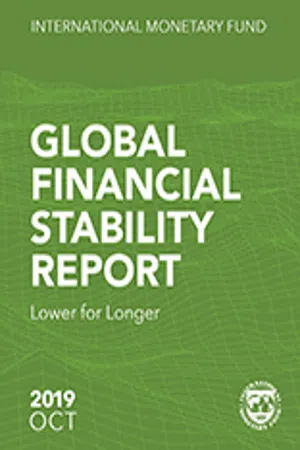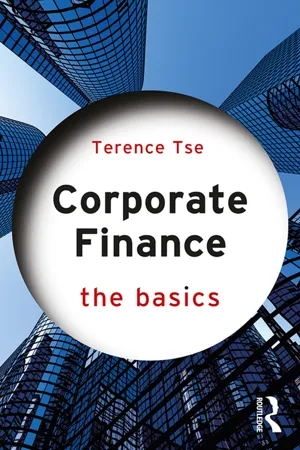Corporate Debt
Corporate debt refers to the money that a company borrows from external sources to finance its operations and expansion. This debt can be in the form of bonds, loans, or other financial instruments. Companies use corporate debt as a way to raise capital, but it also comes with the obligation to repay the borrowed amount along with any agreed-upon interest.
6 Key excerpts on "Corporate Debt"
- eBook - ePub
- Susan McLaughlin(Author)
- 2018(Publication Date)
- Routledge(Publisher)
...The money that banks and other financial institutions lend to companies is ultimately accessed from the public, who deposit money in current or savings accounts. Accessing the public directly can save a company costs by cutting out the bank’s and/or other middle man’s costs and profits. Company borrowing from the public most commonly takes the form of a company issuing corporate bonds or loan notes. These bonds or notes are debt security. Debt security is a broad term encompassing securities issued by a range of issuers which includes companies but also includes, for example, the government. Treasury bonds, for example, are debt securities. Securities regulation imposes strict legal rules on companies offering debt securities to the public. Compliance involves significant legal and administrative costs. Consequently, the issue of debt securities is only practical for raising large sums. Also, the issue of debt securities can only realistically be contemplated by companies that have established good commercial track records and are therefore attractive to investors. Corporate Debt securities are instruments of indebtedness of the company. They are usually freely transferable by the lender and are typically listed on a stock exchange where they are bought and sold just like shares: they are traded in the capital market. The term ‘debenture stock’ is usually reserved for Corporate Debt securities that are secured, typically by a floating charge. ‘Secured’ basically means that the contractual right to be paid is reinforced by a property right (see the next section). This is not always the case, however, and some debenture stock, notwithstanding its name, is not secured. 6.4.6 Secured lending Banks are unwilling to lend large sums to companies on an unsecured basis. Revisit the example of a simple, unsecured, loan contract set out at section 6.4.2 above and consider what the bank can do if the company fails to make a payment to the bank under the agreement, i.e...
- eBook - ePub
The Economy of Promises
Trust, Power, and Credit in America
- Bruce G. Carruthers(Author)
- 2022(Publication Date)
- Princeton University Press(Publisher)
...In a sense, shifting the balance of corporate finance from equity and toward debt increased the importance of the promises that firms made, if only because they were making so many more of them. When those promises took the form of bonds, their credibility was publicly assessed by the bond rating agencies. If they involved loans, then the lending bank conducted a private credit assessment. A highly leveraged firm relies on borrowed money, and the benefits of profitable performance get enjoyed by a smaller number of shareholders. But a more leveraged firm also has less margin for error as it is contractually obligated to meet its bond interest payments. To fail to do so is to default, and such an event sets off a series of unpleasant legal consequences. Why Do Modern Firms Borrow? Modern corporate finance is a much-studied topic, and several theories attempt to explain how and why contemporary firms raise money. 121 The obvious fact is that firms seek capital to finance investment and operations, but there are many ways to do this. The “pecking order” theory posits that firms have adopted a financing hierarchy, starting with retained earnings, then debt, and finally equity. 122 Only when the most-preferred alternative is exhausted do firms move on to the next one, so issuing stock is the measure of last resort. This approach is consistent with the fact that most investments by contemporary U.S. nonfinancial corporations are financed by internal cash flow. 123 Another approach argues that trade-offs between the costs (deadweight losses under bankruptcy) and benefits (e.g., tax advantages) of debt determine its usage, with outcomes weighted by the likelihood of their occurrence...
- International Monetary Fund. Monetary and Capital Markets Department(Author)
- 2019(Publication Date)
- INTERNATIONAL MONETARY FUND(Publisher)
...Debt has risen and is increasingly used for financial risk-taking—to fund corporate payouts to investors, as well as mergers and acquisitions (M&A), especially in the United States. In addition, global credit is increasingly flowing to riskier borrowers. The April 2019 GFSR discussed the credit quality of large firms, BBB-rated bond issuers, and leveraged loan borrowers. This chapter presents a comprehensive assessment of the corporate sector credit quality using the broadest data coverage available. 5 It concludes that debt-at-risk (debt owed by companies whose earnings are insufficient to cover interest payments) and speculative-grade debt 6 are already elevated in several major economies and could approach or exceed crisis levels in an adverse scenario considered by the IMF staff. Banks and nonbank financial institutions with significant exposures to small and medium-sized enterprises (SMEs), syndicated leveraged loans, direct credit, and high-yield corporate bonds may be particularly susceptible to losses in such an adverse scenario and could amplify the shock by curtailing credit to the economy. The Outlook for Firms Has Weakened but Funding Conditions Remain Favorable Slowing global growth and escalating trade disputes have started to affect nonfinancial firms. In China, Europe, and the United States, expected corporate sales have decelerated this year (Figure 2.1, panel 1). In addition, profit margins—although still solid—have declined in the United States this year amid rising wages and elevated input costs (Figure 2.1, panel 2), and managers have become more concerned about tariffs. As a result, corporate earnings forecasts have been revised down since April (Figure 2.1, panel 3)...
- eBook - ePub
- Terence C.M. Tse(Author)
- 2017(Publication Date)
- Routledge(Publisher)
...5 Debt Chapter Overview In general, companies can resort to two major types of capital to finance their capital expenditure. They can sell shares, essentially giving part of the company away in exchange for capital injection into the business, or they can take on debt (i.e. borrow money). Debt is the focus of this chapter. With debt, in return for receiving an immediate loan, a company will typically make regular interest payments and pay back the borrowed sum when it is due. Since the lenders can expect to receive a predetermined amount on a regular basis, debt as a product is often called fi xed income. This chapter examines the two most common forms of debt: bank loans and bonds. Subsequently, it discusses the concept of financial leverage and the implications for companies of using debt. Bank Loans Bank loans as a financing possibility are easy to understand. Individuals and companies can walk into a bank and borrow a certain amount of money, promising to pay interest at an agreed time and frequency. They also promise to return the original loan when it is due. So, if a business takes out a bank loan of £10,000 for 1 year and the bank charges 7 per cent interest, 365 days from now the business must pay the bank both £700 (£10,000 × 7%) in interest and the £10,000 taken out in the first place. This is all rather simple. However, here is a trickier question: is the lending bank an investor in the business? The answer is yes. You may recall that Chapter 1 explained that the income statement of any business shows that lenders, together with shareholders/owners, make up the two groups of investors. Why are lenders investors when they are not becoming a part-owner of the business? Because making an investment does not necessarily require ownership. We also discussed in Chapter 2 that an investment is an opportunity to potentially get more money back than what you put in in the first place...
- eBook - ePub
The Value of Debt
How to Manage Both Sides of a Balance Sheet to Maximize Wealth
- Thomas J. Anderson(Author)
- 2013(Publication Date)
- Wiley(Publisher)
...Proper design and implementation of the company’s capital structure—and their overall debt philosophy—is a key part of these expectations. Interestingly, there are some theories out there that say companies should be almost 99 percent debt and 1 percent equity! 11 Nobel Prizes have been awarded for the theories with respect to corporate finance and the optimal corporate capital structure. It is important that we are familiar with that work and consider its potential implications on our personal lives. If you are a CFO of a public company and you haven’t focused on your optimal debt ratio, do you know what you could be? That’s right: You could be fired! Consider, then, for a moment, what the role of the CFO in a company is. He or she starts by taking a holistic approach to the company’s balance sheet. This begins by considering the corporation’s total assets and the likelihood of the company encountering financial distress, along with what the fallout of that financial distress would be in terms of direct and indirect costs, the impact level of that financial distress, and its duration. (See Chapter 2 for a description of these terms and dynamics.) With all this in mind, the CFO then determines the cash flow needs of the organization, and then looks at how much debt the company should have in terms of accessing the indebted strengths of Increased Liquidity, Flexibility, Leverage, and Survivability. Structuring the right amount of debt in the right way is critical, because if the company takes on too much risk in the form of increased debt then it could go bankrupt. If it doesn’t take on enough of the right kind of debt then it may not be maximizing value and/or may increase the chances of either running into a liquidity crisis or being bought out by a hostile party...
- eBook - ePub
More Than a Numbers Game
A Brief History of Accounting
- Thomas A. King(Author)
- 2011(Publication Date)
- Wiley(Publisher)
...11 DEBT The basic needs of humans are simple: to get enough food, to find shelter, and to keep debt off the balance sheet. —Richard Greene, Forbes, November 24, 1980, cited by Stickney and Weil Practitioners showed little interest in the efficient markets hypothesis. A consequence is that many statement preparers believed outside creditors and investors could be fooled by the “optics” of financial statement presentation. Balance sheet form could seemingly trump economic substance when analysts evaluated a company’s health. This belief manifested itself most clearly in accounting for debt on the balance sheet. The presence of debt came to be viewed as a sign of corporate weakness. Management teams pushed standard setters to permit companies to keep debt off of balance sheet presentation. A balance sheet’s left-hand side displays assets recognized by accounting convention. The right-hand side apportions asset ownership among creditors and owners. Creditors may wrest control from owners if a firm fails to make timely payment for obligations owed. The fraction of a firm’s asset base financed through liabilities is perhaps the most significant issue in corporate finance. Creditor obligations have finite lives, whereas shareholders’ residual claims extend over a corporation’s indefinite life. Owners may receive interim dividend payments, but the firm has no contractual obligation to make these distributions. Shareholders get their money back when they sell shares to other investors in a secondary market or when the firm retires the equity through share repurchase or liquidation. Equity holders bear more risk than creditors and demand higher financial returns. The U.S. tax code since 1894 has permitted interest expense deductions when computing a corporation’s taxable income. The tax code makes no such provision for dividend distributions to investors...





